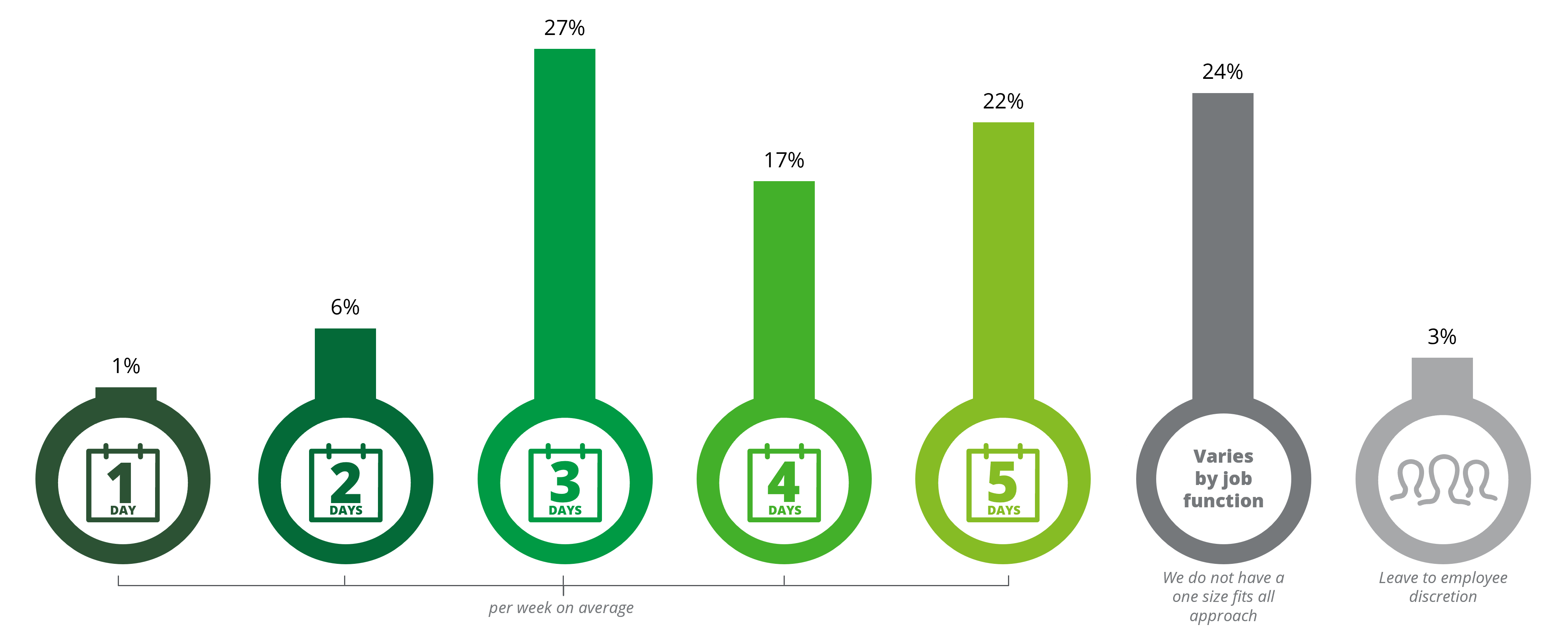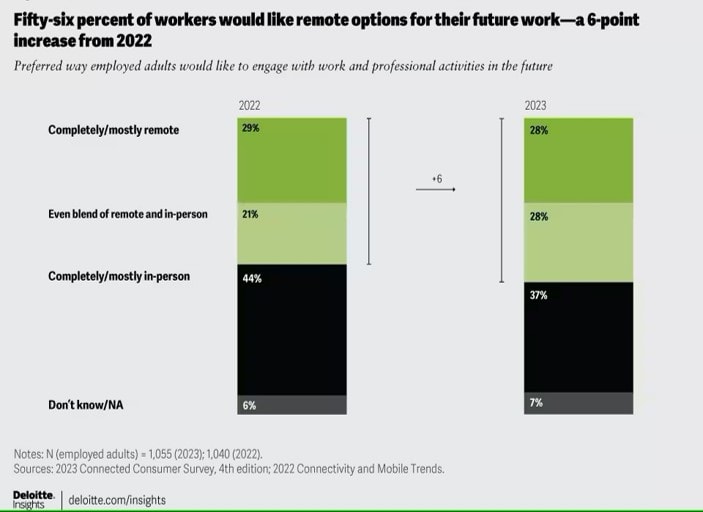CEO perspectives on hybrid work from recent Fortune/Deloitte survey: Embracing the opportunities as well as the challenges has been saved

Perspectives
CEO perspectives on hybrid work from recent Fortune/Deloitte survey: Embracing the opportunities as well as the challenges
CEO Spotlight Series
By Benjamin Finzi, Elizabeth Molacek, and Besty Mann
When it comes to hybrid working, many CEOs call for in-person work at least some of the time but vary on number of days, demonstrating that there's no one formula for the workplace. This edition of our CEO Spotlight Series explores the benefits and challenges that many CEOs are considering when it comes to hybrid working. A great deal has happened since we last discussed this topic in March 2023. During this time, talent issues have remained high on CEOs’ lists of challenges, even as other disruptors, such as geopolitics and inflation, have grown in significance.
Hybrid work: No clear consensus
As part of the Fall 2023 Fortune/Deloitte CEO Survey we asked leaders their preferences on hybrid work. More than a quarter (27%) of respondents—the most popular response—said three days per week on average is the ideal amount of time for workers to be in the office or at client sites. More than a fifth (22%) said they believe workers should be on-site five days per week, and just 6% of CEOs thought that two days per week was ideal (Figure 1). About a quarter of CEOs (24%) said their organization’s approach to hybrid work varies by job function—meaning their companies don’t have a standard approach—and 3% of CEOs said they leave it up to workers to decide. The varying responses from CEOs indicate there is no clear consensus on how to approach hybrid work. Perhaps CEOs are weighing the opportunities and benefits with the challenges and trade-offs to hybrid work.
Common Themes
No one size fits all
There is no universal approach to hybrid work and it may even differ among teams in the same organization.
Well-being matters
Consider well-being—both your workforce's and your own—when establishing a hybrid culture.
Consider company values
When understood throughout an organization, company values can offer one way to shape hybrid work models.
${column4-title}
Embracing new ways of working
Hybrid and remote work configurations have radically changed ideas about employee engagement and productivity, and the effects have been far-reaching. In the Fall 2022 Fortune/Deloitte CEO survey, more than half of respondents agreed that as hybrid and remote arrangements become more embedded in the workplace, employee engagement and loyalty will decrease. At the same time, executives reported plans to develop new tools to drive engagement and loyalty for employees that don’t depend on working in the office and empower workers by allowing a workplace culture with more flexibility and predictability in hours and locations.
All of this is happening amid a historic workplace transformation. With flexible schedules, many workers can pick their own hours of peak performance. Collaboration tools can let colleagues in remote locations work virtually and receive feedback in real time. And companies are even experimenting with shorter workweeks. According to a Deloitte survey of consumer attitudes toward “digital life,” more than half of employed adults work from home at least part of the time, and one-third of those work a hybrid schedule, averaging 3 days in-office and 2.6 days working at home. Despite this momentum for hybrid work—and the novel technology solutions that make it possible —surveyed CEOs report no clear consensus on just how much time employees need to spend in the office or at client sites.

Surveyed CEOs report varying preferences for the amount of time employees work in the office and/or at client sites.
Figure 1: What is the preferred number of days you would like employees to work in the office and/or at client/customer sites? Source: Fortune/Deloitte CEO Survey Fall 2023
Engagement remains a top concern
Talent concerns have been high on the CEO agenda since the start of COVID-19. For instance, in the Winter Fortune/Deloitte CEO 2021 survey, 75% of surveyed CEOs responded that they required less office space than before the pandemic. That summer, when asked about the biggest change initiatives in the works, 71% of CEOs cited workforce and talent transformation. Since June 2020 (the start of the Fortune/Deloitte CEO Survey), when we've asked CEOs about the external disruptors they expect to disrupt their business strategy over the next 12-months, labor/skills shortage has consistently ranked in the top five. During this period, there were varying degrees of hybrid vs. in-person expectations, which can make it harder to attract or retain talent. However, in the recent Fall 2023 survey, a shift occurred—with labor/skills shortage ranking fourth on the list (tied with regulation), behind geopolitical instability, inflation, and other sources of financial instability.
Current events and the economic environment have likely shifted CEO sentiment on disruptors, but the tools and capabilities of enabling remote and hybrid work have improved, which may give more control over talent-related expectations. Yet, sentiment regarding workforce engagement remains prevalent. When asked about their biggest challenges as CEO, many executives shared concerns about worker engagement—coming up with ways to get people back into the office and struggles with designing workplaces to keep people engaged in this hybrid world. Respondents cited challenges such as, “creating the new ‘normal’ including designing the future of work and evolving the hybrid workplace with a heterogeneous and diverse workforce,” and “talent—motivation to come to the office” as well as “retaining talent and maintaining competitiveness and culture as we work in a hybrid environment.”
If hybrid work arrangements are here to stay, what, then, is the right balance for hybrid work? Research suggests that an intermediate number of days in office—from one to two days—may be the sweet spot: A recent working paper from Harvard Business School found that one or two days in the office is the optimum amount of time for hybrid work as it resulted in more emails sent, a higher number of recipients, and increased novelty of work products, while at the same time providing people with greater work-life balance and connections with colleagues.
Getting hybrid work culture right: Beyond productivity
Indeed, the shift to hybrid workplaces has ramifications beyond productivity, which was described by one CEO respondent in January 2022 as the challenge of “maintaining culture and cohesion in a largely virtual world.” In our most recent Fall 2023 survey, another CEO cited “people, culture, and managing remote workforce” as one of the top challenges. As our survey results show, some executives seem to prefer more face time from employees, even if studies suggest that hybrid work does not constitute a drag on productivity.
Although some executives may remain concerned about worker engagement, a growing share of workers want hybrid arrangements (Figure 2) and say they’re having more success balancing home and family responsibilities with work. Indeed, a Deloitte study on consumer technology trends shows that hybrid workers expressed higher job satisfaction than other workers, and at least eight in 10 respondents said their relationships with relatives, co-workers, and managers have improved or stayed the same, compared to when they worked on-site full-time. Finding the right formula for the hybrid workplace is a matter of championing employees’ well-being as much as their immediate productivity.

Figure 2: Preferred way employed adults would like to engage with work and professional activities in the future
Sources: Deloitte 2023 Consumer Survey, 4th edition; Deloitte 2022 Connectivity and Mobile Trends.
Hybrid work: Who gets to decide?
In a recent survey of hybrid workers by Deloitte:
- 54% said it's their employer's decision that they work a hybrid schedule.
- 30% arrived at the decision with their employer.
- 28% would like an even blend of remote and in-person work, a 7-point increase from 2022.
What’s clear is that approaches to hybrid work are not "one size fits all", but require deep consideration and nuance for each business, and, according to 24% of CEOs, sometimes even across roles. With so much variance, how can leaders find the path forward? One solution might be to consider your company’s values when determining work arrangements. Vincent Firth, consulting managing director and co-leader of Deloitte’s Chief Executive Program, explains, “We worked recently with a CEO who told us that they feel strongly about people working together in an office for learning and networking purposes, acknowledging that most of the staff in their industry is on-site. They were clear with their approach that there needs to be a translation of that to their company’s office configurations.”
Conclusions: Keeping it flexible
After several years into one of the biggest shifts in workplace configurations, it’s become clear that hybrid work is not only a variable to productivity and costs. It’s also influencing how leaders approach workplace culture writ large. For executives who are trying to decide how to factor hybrid work into business priorities, some considerations:
- Inspire trust. Making decisions about hybrid arrangements should go deeper than anecdotal understanding. Rather, leaders use data and analytics at their disposal to make talent decisions that build trust.
- Be a champion for well-being. Don’t underestimate the power of a public declaration of CEO support for well-being—especially when workers and teams are distributed. Make it a habit to report on your organization’s progress in this area—and share how you are practicing well-being in a hybrid environment.
- Embrace hybrid work flexibility. Even as organizations make decisions about hybrid arrangements, the past few years have taught us the degree to which workplace conditions can change. Make sure you have the right conditions in place to flex with the changing needs of your workforce.
- Anchor on company values. There is no one size fits all approach to hybrid work—perhaps even across teams within an organization. Yet company values are typically widely understood and adopted, shaping workplace culture around collaboration, performance, and well-being. Explore how your company's values can be demonstrated by hybrid work arrangements.
About the Fortune/Deloitte Fall 2023 CEO Survey
104 CEOs representing more than 26 industries participated in this Fortune/Deloitte CEO Survey. 93% of respondents are from organizations based in the United States, and the remainder are from organizations based outside of the United States.
Fielded October 3-11, 2023, the survey consisted of 17 questions that explore market outlook and predictions, Generative AI, and business priorities. Surveyed CEOs include Fortune 500 CEOs, Global 500 CEOs, and select public and private CEOs in the global Fortune community.
This Fall 2023 survey is the 11th edition of the Fortune/Deloitte CEO survey series. Information on previous surveys is available here.
Authors
Benjamin Finzi |
Elizabeth Molacek, PhD |
Betsy Mann |
Recommendations
Key Considerations on the Path to CEO: Lessons Learned from Deloitte’s Next Generation CEO Program
CEO Spotlight Series
A new era of CEO leadership in the talent space
The CEO as orchestrator




